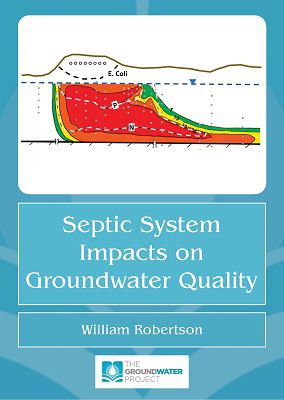Even though communal sewage treatment systems have been in place in urban centres for centuries, a surprisingly large number of households still discharge their wastewater to on-site treatment systems such as septic systems. Septic systems are used by approximately 25% of the population in the US, and it is estimated that more than 500,000,000 on-site treatment systems are in use worldwide. On-site treatment is used in rural areas, but more recently, has also been promoted in some urbanized areas, because of perceived lower capital costs and lower energy consumption compared to conventional sewage treatment. Domestic wastewater is rich in nutrients, including nitrogen and phosphorus and has other constituents that exceed drinking water criteria, and as such, wastewater discharged to septic systems represents a potential threat to aquatic ecosystems, and imposes a risk of groundwater contamination. However, a number of treatment steps occur in the subsurface at septic system sites, that have the potential to diminish the contaminant risk. This book examines groundwater plume development from septic systems with a particular focus on the fate of nitrogen and phosphorus. Two field sites in particular; one with a household septic system, and the second at a large campground, are used to illustrate plume development and contaminant fate in septic system plumes. Finally, comparisons are made between the degree of treatment provided in the subsurface at septic system sites, to that provided by conventional sewage treatment.
Septic System Impacts on Groundwater Quality

Publication year: 2021
Number of pages: 38
ISBN: 978-1-77470-004-4
Author:
William Robertson: University of Waterloo, Canada
Please donate to support us in providing free high-quality education to the global groundwater community.
Thank you,
John Cherry
Last Update: 3 August 2021
Released: 23 April 2021
5329
Septic System Impacts on Groundwater Quality
1 file(s) 2.24 MB
Arabic translation by Khalil Ibrahim Al-Samarrai
Released: 31 May 2024
19306
تأثير نظام الصرف الصحي على نوعية المياه الجوفية
1 file(s) 2.19 MB
Persian translation by Mohammad Hossein Aref
Released: 11 October 2023
13853
تاثیرات†سیستم†سپتیک†برکیفیت†آب†زیرزمین†ی
1 file(s) 2.93 MB
Portuguese translation by Thaís de Paula Marteleto, Daniel Souza dos Santos, Joana de Miranda Alencar, and Paula Cristina Neuburger de Oliveira
Released: 13 June 2023
12718
Impactos de Sistemas Sépticos na Qualidade da Água Subterrânea
1 file(s) 2.21 MB
Vietnamese Translation by Nguyễn Như Huế
Released: April 16 2024
18452
Tác động của Hệ thống Bể Tự hoại lên Chất lượng Nước ngầm
1 file(s) 2.38 MB
Description
Interview with the Author
Thank you for signing up to our email list!
Contents
1 WHAT IS A SEPTIC SYSTEM?
2 POTENTIAL FOR CONTAMINATION FROM SEPTIC TANK EFFLUENT
3 FATE OF PATHOGENS DURING ON SITE WASTEWATER DISPOSAL
3.1 Bacteria
3.2 Viruses
4 SEPTIC EFFLUENT CHEMISTRY AND TREATMENT
4.1 Treatment in the Septic Tank (Anaerobic)
4.2 Treatment in the Unsaturated Zone (Aerobic)
5 SEPTIC SYSTEM PLUME FORMATION AND DISPERSION
5.1 Plume Tracers – Major Ions; (EC,Cl–,NO3–,Na+)
5.2 Plume Tracers – Minor and Trace Constituents – Boron
5.3 Plume Tracers – Artificial Sweeteners (Acesulfame and Sucralose)
5.4 Isotopic Tracers – Nitrate – 15N
6 FATE OF NITROGEN IN SEPTIC SYSTEM PLUMES
7 FATE OF PHOSPHORUS IN SEPTIC SYSTEM PLUMES
7.1 Acid Buffering Reactions
7.2 Reactions Involving Phosphorus Minerals
7.3 Phosphorus Fate
8 FATE OF TRACE ORGANIC CONSTITUENTS IN SEPTIC SYSTEM PLUMES
9 FAILING SEPTIC SYSTEMS
10 EXERCISES
11 REFERENCES
EXERCISE SOLUTIONS
ABOUT THE AUTHOR
Thank you for signing up to our email list!
